Choline and Acetylcholine / Taste Components / Liquid for Permanent Wave
Choline and Acetylcholine
Choline and acetylcholine are important components of living organism as autacoid. Choline and acetylcholine separated by RSpak DE-613 or DE-413 are converted to hydrogen peroxide (H2O2) by AFpak ACH-494, a column with choline oxidase and acetylcholine esterase immobilized. This hydrogen peroxide can be detected by an electrochemical detector (ECD). We recommend that DE-413 is used to reduce analytical time.
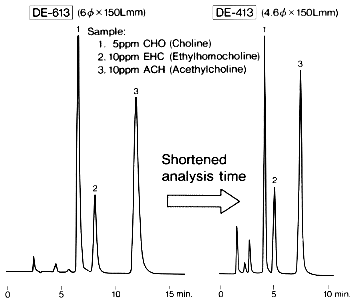
Sample :
1. CHO (Choline)
2. EHC (Ethylhomocholine)
3. ACH (Acetylcholine)
Columns : Shodex RSpak DE-613 (6.0mmID*150mm), DE-413 (4.6mmID*150mm)
Post column : Shodex AFpak ACH-494 (4.6mmID*10mm)
Eluent : 0.1M Phosphoric acid + 300mg/L Sodium 1-decansulfonate
+ 65mg/L Tetramethylammonium chloride(pH8.0 adjusted by 1M NaOH)
Flow rate : 1.0mL/min
Detector : ECD (Electrode: Pt, 350mV SCE)
Column temp. : 37deg-C
Taste Components
Asahipak GS-320 7E is a multimode column and capable of analyzing typical nucleic acids components for taste, i.e. IMP, GMP and AMP (nucleotide), and all of their metabolites with simple isocratic elution. The main characteristic of the column is that the nine components(IMP, GMP, AMP and their respective nucleotides, purine bases and pyrimidine bases) are completely separated for approximately 30 minutes and elute in order of nucleotides, nucleosides, purine bases and pyrimidine bases.
GS-320 7E is an old type of GS-320 HQ.
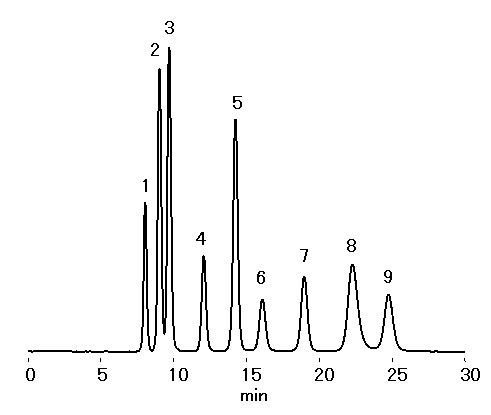
Sample : 50micro-g/mL each, 20micro-L
1. IMP
2. GMP
3. AMP
4. Inosine
5. Hypoxanthine
6. Guanosine
7. Guanine
8. Adenosine
9. Adenine
Column : Shodex Asahipak GS-320 7E (7.5mmID*250mm) Eluent : 10mM NaH2PO4 aq. Flow rate : 1.0mL/min Detector : UV(260nm) Column temp. : 40deg-C
The elution volume of Nucleic acids in taste components analyzed with Asahipak GS-320 7G (a multimode column) and an ODS column were compared .
GS-320 7G is an old type of GS-320 HQ.
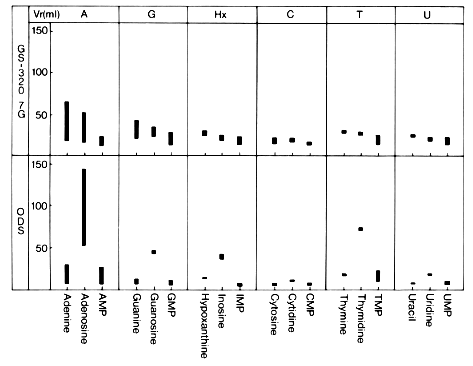
Sample :
Adenine, Adenosine, AMP, CMP, Cytidine, Cytosine, GMP, Guanine, Guanosine, Hypoxanthine
IMP, Inosine, Thymidine, Thymine, TMP, UMP, Uracil, Uridine
Columns : Shodex Asahipak GS-320 7G (7.5mmID*500mm), ODS column (6.0mmID*150mm) Eluent : 10mM Sodium phosphate buffer(pH2.5 to 10) Flow rate : 1.0mL/min (GS-320 7G), 0.6mL/min (ODS column) Detector : UV(260nm) Column temp. : 30deg-C
Decomposition of ATP is an important biochemical postmorten change in muscles of fish and shellfish. During this process, ATP, ADP, and AMP decompose quickly to form a build-up of inosine and hypoxanthine. As this corresponds well with a decline in freshness, the ratio of the quantity of inosine and hypoxanthine to the total quantity of ATP and related substances is called the K value and used as an index representing freshness of fish meat.
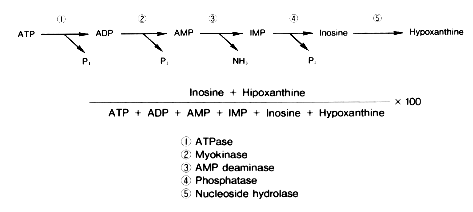
ATP related substances in scallops were analyzed using Asahipak GS-320 7G ( a multimode column ).
GS-320 7G is an old type of GS-320 HQ.
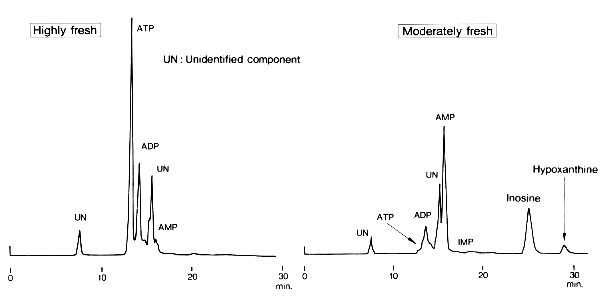
Sample : ATP, ADP, AMP, IMP, Hypoxanthine, Inosine
Column : Shodex Asahipak GS-320 7G (7.5mmID*500mm) Eluent : 100mM Sodium phosphate buffer(pH3.0) Flow rate : 1.0mL/min Detector : UV(260nm)
Courtesy of Dr.Fukuda, National Research Institute of Fisheries Science
ATP related substances in muscle of sea food were analyzed using Asahipak GS-320 7G ( a multimode column ).
GS-320 7G is an old type of GS-320 HQ.
(A) Standards
(B) Sea bass just after death
(C) Ascidian after strage for one day at 2deg-C
(D) Spring lobster after strage for 12 hours at 20deg-C
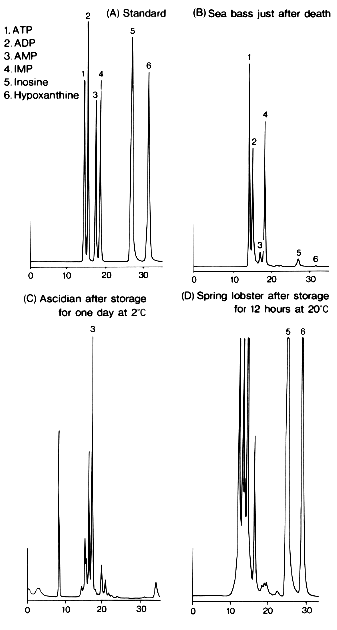
Sample :
1. ATP
2. ADP
3. AMP
4. IMP
5. Inosine
6. Hypoxanthine
Column : Shodex Asahipak GS-320 7G (7.5mmID*500mm) Eluent : 200mM Sodium phosphate buffer(pH2.9 to 3.0) Flow rate : 1.0mL/min Detector : UV(260nm) Column temp. : Room temp.
Courtesy of Dr. Yamanaka, Tokyo Unversity of Fisheries and Dr. Matsumoto, Ochanomizu University
Liquid for Permanent Wave
RSpak NN-814 packed with polyhydroxymethacrylate gel is a column for reversed phase mode like RSpak DE-613. A small number of sulfo groups (counter ion H+) bonded to the packings, however, characterize NN-814. When a neutral or acidic eluent is used, acidic, neutral and basic substances in principle elute in this order. Taking this advantage, NN-814 enables complicated components such as permanent wave solution to be analyzed by simple isocratic elution with good reproducibility.
In NN-814, ion exclusion, ion exchange and reversed phase modes have effect on separation. Here, acidic substances such as TGA and DTGA elute first as they are affected mainly by the ion exclusion mode. In contrast, basic substances such as ammonia and monoethanolamine elute later as they are affected mainly by the ion exchange mode. Other components are affected mainly by the reversed phase mode.
Permanent wave solution was analyzed using RSpak NN-814.
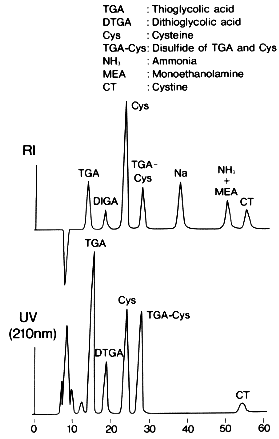
Sample :
1. TGA, Thioglycolic acid
2. DTGA, Dithioglycolic acid
3. Cys, Cysteine
4. TGA-Cys:Disufide of TGA and Cys
5. NH3, Ammonia
6. MEA, Monoethanolamine
7. CT, Cystine
Column : Shodex RSpak NN-814 (8.0mmID*250mm) Eluent : 9.6mM NaH2PO4(pH2.68 adjusted by H3PO4) Flow rate : 1.0mL/min Detector : UV(210nm), Shodex RI Column temp. : 45deg-C
Organic acids in liquid for permanent wave were analyzed using RSpak NN-814.

Sample :
1. Thioglycolic acid
2. Dithioglycolic acid
3. Cysteine
4. Thioglycolic acid and cysteine mixture disulfide
Column : Shodex RSpak NN-814 (8.0mmID*250mm) Eluent : 0.06% H3PO4 + 0.138% NaH2PO4 aq. Flow rate : 1.0mL/min Detector : Shodex RI Column temp. : 45deg-C
